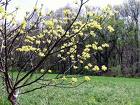Smelling Stick Tree Information
Images of Smelling Stick:






Smelling Stick grows in the following 32 states and provinces:
Alabama, Arkansas, Connecticut, Delaware, Florida, Georgia, Illinois, Indiana, Iowa, Kansas, Kentucky, Louisiana, Maine, Maryland, Massachusetts, Michigan, Mississippi, Missouri, New Hampshire, New Jersey, New York, North Carolina, Ohio, Oklahoma, Pennsylvania, Rhode Island, South Carolina, Tennessee, Texas, Vermont, Virginia, West VirginiaInformation about Smelling Stick:
The Sassafras Albidum is commonly known as the Ague Tree, Cinnamon Wood, Common Sassafras, Gumbo File, Mitten Tree, Saloop, Sassafras, Smelling Stick as well as White Sassafras.
The currently accepted scientific name of sassafras is Sassafras albidum (Nutt.) Nees. . Some authorities consider red sassafras a distinct variety ; other authors consider it synonymous with the type variety .Sassafras occurs from southwestern Maine west to extreme southern Ontario and central Michigan; southwest to Illinois, Missouri, eastern Oklahoma, and eastern Texas; and east to central Florida. It is extinct in southeastern Wisconsin, but its range is extending into northern Illinois .The sassafras-persimmon (Diospyros virginiana) cover type is a successional type common on abandoned farmlands throughout its range. Sassafras is a common component of the bear oak (Quercus ilicifolia) type, which is a scrub type on dry sites along the Coastal Plain . In dry pine-oak forests, sassafras sprouts prolifically and is a shrub-layer dominant . It achieves short-term dominance by producing extensive thickets where few other woody plants can establish . In the northern parts of its range, sassafras occurs in the understory of open stands of aspen (Populus spp.) and in northern pin oak (Q. ellipsoidalis) stands . Common tree associates of sassafras not previously mentioned include sweetgum (Liquidambar styraciflua), flowering dogwood (Cornus florida), elms (Ulmus spp.), hickories (Carya spp.), and American beech (Fagus grandifolia). Minor associates include American hornbeam (Carpinus caroliniana), eastern hophornbeam (Ostrya virginiana), and pawpaw (Asimina triloba). On poor sites, particularly in the Appalachian Mountains, sassafras is frequently associated with black locust (Robinia pseudoacacia), and sourwood (Oxydendron arboreum). In old fields with deep soils, sassafras commonly grows with elms, ashes (Fraxinus spp.), sugar maple (Acer saccharum), yellow-poplar (Liriodendron tulipifera), and oaks . Sassafras is listed as a subdominant on subxeric and submesic sites in the following classification: Landscape ecosystem classification for South Carolina .Some of the information provided here is attributed to:Sullivan, Janet. 1993. Sassafras albidum. In: Fire Effects Information System, [Online]. U.S. Department of Agriculture, Forest Service, Rocky Mountain Research Station, Fire Sciences Laboratory (Producer). , available at the USDA Fire Effects Information System (FEIS) website